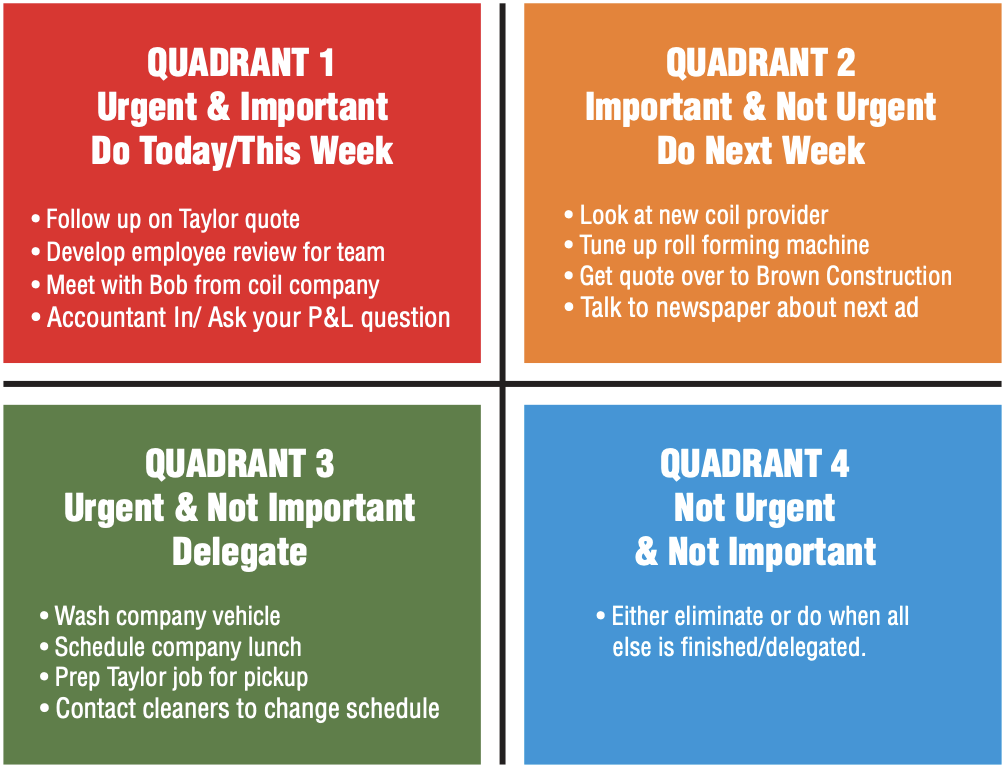Better Time Management
Chris Ray, National Sales Manager at Levi’s Building Components, presented “Sell More – Better” at the Construction Rollforming Show on December 12 in Cincinnati. The engaging and insightful talk taught attendees how sales people could connect with potential customers in such a way as to be more likely to begin a true buyer-seller relationship. (See Rural Builder, February 2020) Ray included a “bonus” presentation about time management, a summary of which you find here.
What’s the one thing you spend every day and can never get back? Time! This makes time one of our most precious commodities. It’s a commodity that should be spent and invested wisely.
Ray explained in his presentation that everything we do in business and with our time should be looked at in terms of return on investment (ROI).
If you have more to do than you can do in a day, week, or even a month, there are a lot of us that live there. It’s kind of a normal place to be. While it’s not a bad thing to always have something to do, the problem is that if the list of things to do is too long, chances are some important things are going to be prioritized incorrectly and become emergencies. That’s called reacting rather than pro-acting. Pro-acting is looking at a list and taking action before it gets there.
Some people put their “to do” points on Post-It notes. For someone with a great many things to do, the field of notes comes to look like wallpaper. While it captures a thought and acts as a reminder, it doesn’t prioritize the tasks. The chaotic arrangement is indicative of how things are going to get done – without order and possibly reactively.
Establishing Order
President Dwight Eisenhower had a lot to do. He came up with the Eisenhower Matrix to help prioritize “to do” lists so tasks can be handled pro-actively rather than reactively. The Matrix has four quadrants: Quadrant 1 is labeled Urgent & Important; Quadrant 2 is labeled Important, Not Urgent; Quadrant 3 is labeled Urgent, Not Important; and Quadrant 4 is labeled Not Urgent & Not Important.
Ray explained how using the Eisenhower Matrix simplifies what you have to do. It helps you prioritize the things that need to get done.
Begin by creating an alpha list that includes everything you need to do in the coming week. Here’s a sample list:
- Wash company vehicle
- Follow up on Taylor quote
- Contact office cleaners to change schedule
- Accountant In/ Ask your P&L
question - Develop employee review team
- Schedule company lunch
- Meet with Bob from oil company
- Get quote over to Brown
Construction - Prep Taylor job for pickup
- Tune up roll forming machine
- Talk to newspaper about next ad
- Look at new coil provider
As your list grows, the chance that something may not get done grows.
Once your list is complete, circle each item and draw a line to its appropriate quadrant. Here’s how the prioritization ends up:
Quadrant 1: Urgent & Important: Do these tasks first (now).
Quadrant 2: Not Urgent & Important: Do these tasks later.
Quadrant 3: Urgent & Not Important: Delegate these tasks.
Quadrant 4: Not Urgent & Not
Important: Eliminate.

The things that you prioritize in the Not Urgent, Not Important quadrant you can either eliminate or do when the rest of your tasks are complete. What you’ve just done is create time for yourself using the Matrix.
Consider Delegating
Chances are in your list there are things in your list that you can delegate. In the sample list, those items include wash the company vehicle, schedule the company lunch, prep the Taylor job for pickup, and contact the cleaners to change the schedule. Delegate the things on your list that don’t need your skills or experience or position to get done.
Delegation is entrusting a task or responsibility to another person. The Miriam Webster Dictionary defines delegation as “To entrust to another; to appoint as one’s representative.”
Why delegate a task? It creates time for you so you can focus on and handle your urgent and important tasks. (Washing the company vehicle probably isn’t the best use of your time.)
Delegating also builds trust; it’s a message to your team member that you trust them. When you empower employees to do things for you, they learn. If you delegate to them, chances are some element of what you’re delegating to them is something they haven’t done before. It might be something that challenges them, or it might be something that they can do really well. You may discover your employee has skills you never knew about; you may even discover a superstar.
You enrich your employee, and you enrich your company by delegating some tasks that you would otherwise have done yourself.
In order to delegate well, you first need to choose the right person for the job. Ideally, there will be some space for them to learn and grow with the project.
Explain why you’re delegating so they don’t see it as something that doesn’t have any value. Don’t just tell somebody, “Hey, go do this.” And then walk away from them. Then it’s just a busy thing they have to get done. Tell them why it needs to get done.
You also need to tell them the right instructions. Tell them what you’re looking for. Get their buy-in on the project and give them a timeline and deadline. Getting their buy-in will result in getting a better product or project back from them.
It’s also very important to give them the resources and training so they can get the job done right.
Managing your time better will help you create more time for the tasks only you can do, and allow you to do them better. GCSB
Editor’s Note: This article is excerpted from Chris Ray’s educational presentation, “Sell More – Better,” given at the first annual Construction Rollforming Show. Ray is the National Sales Manager at Levi’s Building Components. The second annual Construction Rollforming show is scheduled for December 10-11, 2020. It will again be held at the Duke Energy Convention Center in Cincinnati, Ohio, and will offer an expanded educational programming schedule.






















